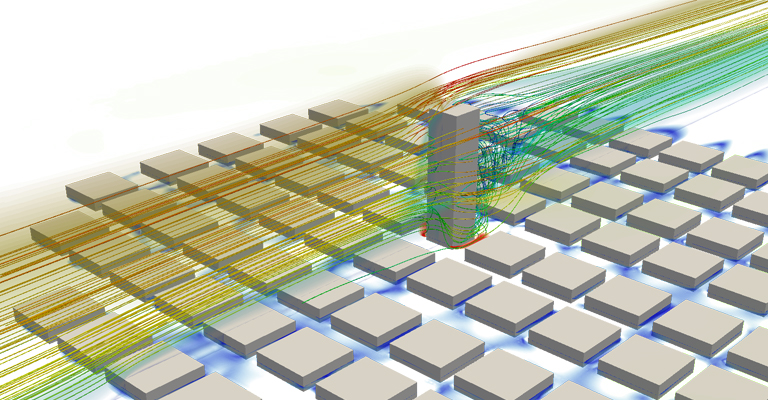Wind, one of the most powerful manifestations of nature, is present everywhere. And as long as humans have inhabited the earth, it has been a source of mystery, fear and even devotion. Our curious minds have long tried to understand the nature of gusts, hurricanes, and calm winds. Why do they occur? How do they behave? What threats do they pose? And more importantly, how can we benefit from them? From all of these questions, the field of wind engineering was born.
Wind engineering is a very exciting area of knowledge, as it has so many practical applications (some of which we will investigate below), which also turn out to be relevant for many aspects of our daily lives. Some of its benefits are unknown to many people, even though they benefit from it in a significant manner.
Numerical Simulation with CFD
Wind-related technology depends on the ability of engineers to understand and predict flow behavior. This specific requirement fuels the centuries-long quest for equations and rules to model fluid flow, a quest that is still relevant today and poised to drive research for many years to come.
Computational fluid dynamics (CFD) is one of the most important achievements of this research field. Its power resides in the ability to apply physical fluid models to almost any geometry, which is done by leveraging the use of numerical methods and digital computers. And because of this last characteristic, its application power has grown hand-in-hand with the growth in computing power.
But one common limitation that practical applications of CFD have found is related to this very same computing power aspect. Regular workstation computers often lack the required amounts of memory and processing speed to run viable models—this means sufficiently fine, convergent mesh densities of geometrically accurate and detailed models. Simulation engineers then have to rely on approximated and simplified models to carry out their work in a reasonable time, sacrificing the full potential of the technique.
Cloud Computing and SimScale

This problem has led to the creation of supercomputers and parallel computing networks. But these solutions are expensive to implement and maintain, which puts them out of the reach of the majority of professionals. On the other hand, the advent of cloud computing has shed a new light on the matter. Remote Internet computer servers can be put to work for CFD simulations on demand, with high computing power and cost reduction.
The SimScale platform is exactly this! It puts cloud computing power in the hands of engineers in an easy, affordable and reliable way. By leveraging cloud computing, all processing and data storage is done remotely, with automatic security and backups. And it is accessed through the web browser, so there is no need to install and manage local software and licenses. It even has a free Community account and public reference projects to help one test and start simulating right away.
Sign up & check out our SimScale blog for much more!
Wind Engineering Applications
Below we will present some very exciting applications related to wind engineering, with example projects available on the SimScale platform. By leveraging the CFD technology and cloud computing, wind engineers gain the power to accurately simulate systems for testing, design, and optimization.
Wind Loads on Buildings and Structures

Wind can also be a cause of catastrophes, especially when dealing with human-built structures. High-speed winds pressure over tall buildings, bridges, publicity billboards and the like, can cause collapse and harm people. Construction codes generally present formulas to deal with wind loading, but with complex geometries and surrounding conditions, the case can fall out of the code’s reach and may need further investigation, such as using CFD simulations.
Wind Comfort

Another wind-related source of risk for humans is wind flow around buildings in urban areas. The presence and shape of buildings can create vortexes, turbulence and tunneling effects that can discomfort or even harm people. Often, these effects are only noticed after the building is complete, at which point mitigation is often difficult and expensive. However, with the use of simulation, these issues can be predicted and corrected in the design phase. Our last example project above is a validation of pedestrian wind comfort in a city of Japan.
Wind Energy

Wind energy is a very hot topic nowadays. Although it has been present in many forms for a long time, such as in windmills and sailboats, with the recent rise of renewable energy sources, it has taken a renewed protagonism. With the phasing away of fossil fuels, it is poised to gain even more prevalence. In the example project above, a wind farm is simulated to identify the best placement of the wind turbines.
Conclusion
If you are a wind engineer, you no longer have any excuses for not making use of CFD. With the SimScale platform, you have ready access to the powerful software and hardware needed to tackle any simulation challenge. And with SimScale’s learning resources, example projects and great community, you get even more added value for your projects. So, what are you waiting for? Start simulating today!
To learn how you, as a designer, engineer or architect can benefit from virtual prototyping, download this free infographic!





